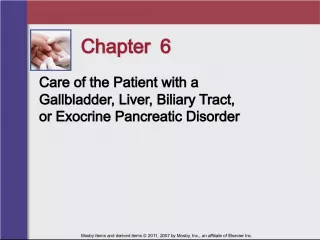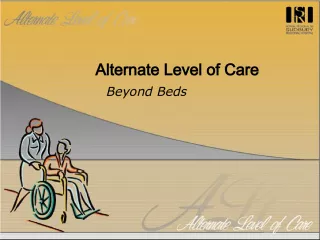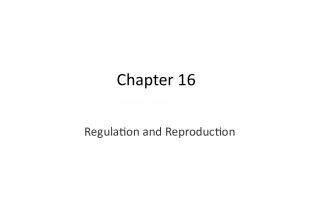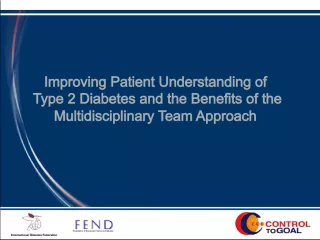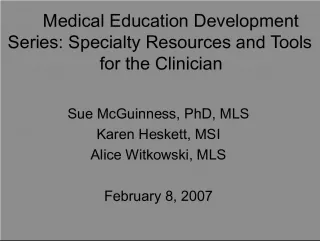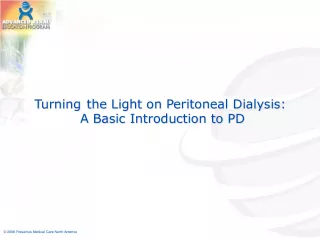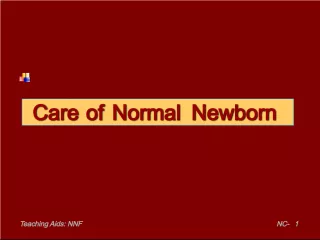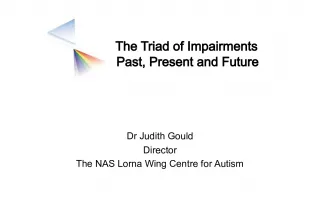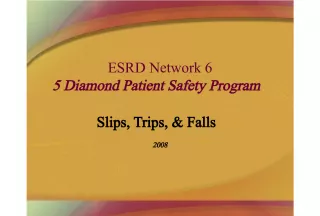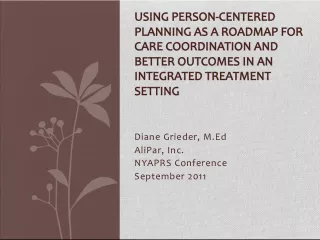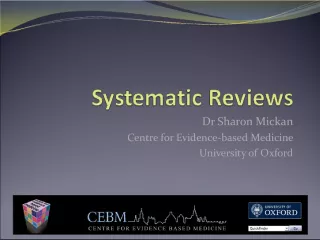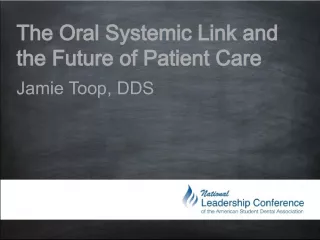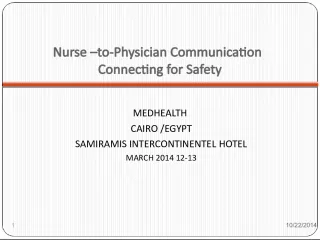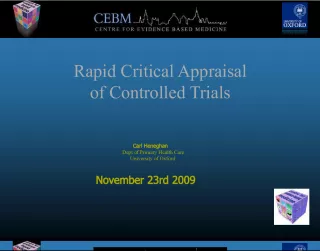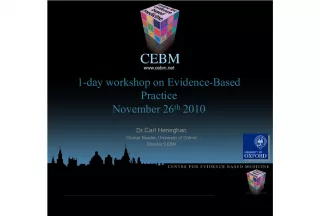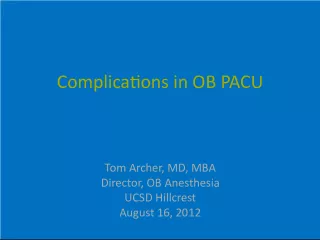Care of the Patient with an Endocrine Disorder
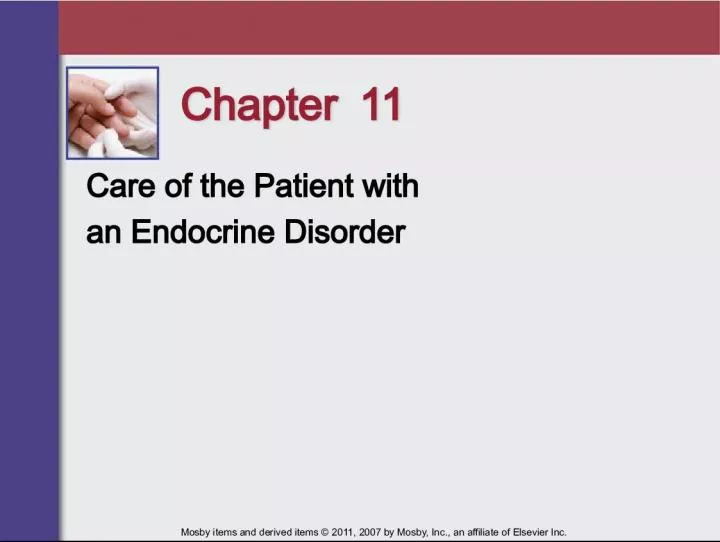

This chapter discusses the care and management of patients who have been diagnosed with an endocrine disorder. The endocrine system is comprised of ductless glands and hormones, which play a crucial
- Uploaded on | 13 Views
-
 polyan
polyan
About Care of the Patient with an Endocrine Disorder
PowerPoint presentation about 'Care of the Patient with an Endocrine Disorder'. This presentation describes the topic on This chapter discusses the care and management of patients who have been diagnosed with an endocrine disorder. The endocrine system is comprised of ductless glands and hormones, which play a crucial. The key topics included in this slideshow are . Download this presentation absolutely free.
Presentation Transcript
Slide1Chapter 11 Chapter 11 Care of the Patient with an Endocrine Disorder Mosby items and derived items © 2011, 2007 by Mosby, Inc., an affiliate of Elsevier Inc.
Slide2Slide 2Mosby items and derived items © 2011, 2007 by Mosby, Inc., an affiliate of Elsevier Inc. Overview of Anatomy and Physiology Overview of Anatomy and Physiology • Endocrine glands and hormones The endocrine system is composed of a series of ductless glands It communicates through the use of hormones • Hormones are chemical messengers that travel though the bloodstream to their target organ
Slide3Slide 3Mosby items and derived items © 2011, 2007 by Mosby, Inc., an affiliate of Elsevier Inc. • Pituitary gland—“master gland” Anterior pituitary gland Posterior pituitary gland • Thyroid gland • Parathyroid gland • Adrenal gland Adrenal cortex Adrenal medulla • Pancreas Overview of Anatomy and Physiology Overview of Anatomy and Physiology
Slide4Slide 4Mosby items and derived items © 2011, 2007 by Mosby, Inc., an affiliate of Elsevier Inc. Figure 11-2 Figure 11-2 Pituitary hormones. (From Thibodeau, G.A., Patton, K.T. [2008]. Structure and function of the body. [13 th ed.]. St. Louis: Mosby.)
Slide5Slide 5Mosby items and derived items © 2011, 2007 by Mosby, Inc., an affiliate of Elsevier Inc. • Female sex glands Ovaries Placenta • Male sex glands Testes • Thymus gland • Pineal gland Overview of Anatomy and Physiology Overview of Anatomy and Physiology
Slide6Slide 6Mosby items and derived items © 2011, 2007 by Mosby, Inc., an affiliate of Elsevier Inc. Figure 11-1 Figure 11-1 Location of the endocrine glands in the female and male bodies. (From Thibodeau, G.A., Patton, K.T. [2008]. Structure and function of the body. [13 th ed.]. St. Louis: Mosby.)
Slide7Slide 7Mosby items and derived items © 2011, 2007 by Mosby, Inc., an affiliate of Elsevier Inc. Disorders of the Pituitary Gland Disorders of the Pituitary Gland • Acromegaly Etiology/pathophysiology • Overproduction of growth hormone in the adult • Idiopathic hyperplasia of the anterior pituitary gland • Tumor growth in the anterior pituitary gland • Changes are irreversible
Slide8Slide 8Mosby items and derived items © 2011, 2007 by Mosby, Inc., an affiliate of Elsevier Inc. Disorders of the Pituitary Gland Disorders of the Pituitary Gland • Acromegaly (continued) Clinical manifestations/assessment • Enlargement of the cranium and lower jaw • Separation and malocclusion of the teeth • Bulging forehead • Bulbous nose • Thick lips; enlarged tongue • Generalized coarsening of the facial features • Enlarged hands and feet • Enlarged heart, liver, and spleen
Slide9Slide 9Mosby items and derived items © 2011, 2007 by Mosby, Inc., an affiliate of Elsevier Inc. Disorders of the Pituitary Gland Disorders of the Pituitary Gland • Acromegaly (continued) Clinical manifestations/assessment (continued) • Muscle weakness • Hypertrophy of the joints with pain and stiffness • Males—impotence • Females—deepened voice, increased facial hair, amenorrhea • Partial or complete blindness with pressure on the optic nerve due to tumor • Severe headaches
Slide10Slide 10Mosby items and derived items © 2011, 2007 by Mosby, Inc., an affiliate of Elsevier Inc. Figure 11-6 Figure 11-6 Right: Coarse facial features typical of acromegaly. Left: Patient’s face several years before she developed the pituitary tumor. (Courtesy of the Group for Research in Pathology Education.)
Slide11Slide 11Mosby items and derived items © 2011, 2007 by Mosby, Inc., an affiliate of Elsevier Inc. Disorders of the Pituitary Gland Disorders of the Pituitary Gland • Acromegaly (continued) Medical management/nursing interventions • Pharmacological management Parlodel Sandostatin Analgesics • Cryosurgery • Transsphenoidal removal of tissue • Proton beam therapy • Soft, easy-to-chew diet
Slide12Slide 12Mosby items and derived items © 2011, 2007 by Mosby, Inc., an affiliate of Elsevier Inc. Disorders of the Pituitary Gland Disorders of the Pituitary Gland • Gigantism Etiology/pathophysiology • Overproduction of growth hormone • Caused by hyperplasia of the anterior pituitary gland • Occurs in a child before closure of the epiphyses
Slide13Slide 13Mosby items and derived items © 2011, 2007 by Mosby, Inc., an affiliate of Elsevier Inc. Disorders of the Pituitary Gland Disorders of the Pituitary Gland • Gigantism (continued) Clinical manifestations/assessment • Great height • Increased muscle and visceral development • Increased weight • Normal body proportions • Weakness Medical management/nursing interventions • Surgical removal of tumor • Irradiation of the anterior pituitary gland
Slide14Slide 14Mosby items and derived items © 2011, 2007 by Mosby, Inc., an affiliate of Elsevier Inc. Disorders of the Pituitary Gland Disorders of the Pituitary Gland • Dwarfism Etiology/pathophysiology • Deficiency in growth hormone; usually idiopathic • Some cases attributed to autosomal recessive trait Clinical manifestations/assessment • Abnormally short height • Normal body proportion • Appear younger than age • Dental problems due to underdeveloped jaws • Delayed sexual development`
Slide15Slide 15Mosby items and derived items © 2011, 2007 by Mosby, Inc., an affiliate of Elsevier Inc. Disorders of the Pituitary Gland Disorders of the Pituitary Gland • Dwarfism (continued) Diagnostic tests Medical management/nursing interventions • Growth hormone injections • Removal of tumor, if present
Slide16Slide 16Mosby items and derived items © 2011, 2007 by Mosby, Inc., an affiliate of Elsevier Inc. Disorders of the Pituitary Gland Disorders of the Pituitary Gland • Diabetes insipidus Etiology/pathophysiology • Transient or permanent metabolic disorder of the posterior pituitary • Deficiency of antidiuretic hormone (ADH) • Primary or secondary
Slide17Slide 17Mosby items and derived items © 2011, 2007 by Mosby, Inc., an affiliate of Elsevier Inc. Disorders of the Pituitary Gland Disorders of the Pituitary Gland • Diabetes insipidus Clinical manifestations/assessment • Polyuria; polydipsia • May become severely dehydrated • Lethargic • Dry skin; poor skin turgor • Constipation Medical management/nursing interventions • ADH preparations • Limit caffeine due to diuretic properties
Slide18Slide 18Mosby items and derived items © 2011, 2007 by Mosby, Inc., an affiliate of Elsevier Inc. Disorders of the Thyroid and Parathyroid Glands Disorders of the Thyroid and Parathyroid Glands • Hyperthyroidism Etiology/pathophysiology • Also called Graves’ disease, exophthalmic goiter, and thyrotoxicosis • Overproduction of the thyroid hormones • Exaggeration of metabolic processes • Exact cause unknown
Slide19Slide 19Mosby items and derived items © 2011, 2007 by Mosby, Inc., an affiliate of Elsevier Inc. • Hyperthyroidism (continued) Clinical manifestations/assessment • Edema of the anterior portion of the neck • Exophthalmos • Inability to concentrate; memory loss • Dysphagia • Hoarseness • Increased appetite • Weight loss • Nervousness Disorders of the Thyroid and Parathyroid Glands Disorders of the Thyroid and Parathyroid Glands
Slide20Slide 20Mosby items and derived items © 2011, 2007 by Mosby, Inc., an affiliate of Elsevier Inc. • Hyperthyroidism (continued) Clinical manifestations/assessment (continued) • Insomnia • Tachycardia; hypertension • Warm, flushed skin • Fine hair • Amenorrhea • Elevated temperature • Diaphoresis • Hand tremors Disorders of the Thyroid and Parathyroid Glands Disorders of the Thyroid and Parathyroid Glands
Slide21Slide 21Mosby items and derived items © 2011, 2007 by Mosby, Inc., an affiliate of Elsevier Inc. • Hyperthyroidism (continued) Medical management/nursing interventions • Pharmacological management Propylthiouracil Methimazole • Radioactive iodine • Subtotal thyroidectomy Disorders of the Thyroid and Parathyroid Glands Disorders of the Thyroid and Parathyroid Glands
Slide22Slide 22Mosby items and derived items © 2011, 2007 by Mosby, Inc., an affiliate of Elsevier Inc. • Hyperthyroidism (continued) Medical management/nursing interventions (continued) • Postoperative Voice rest; voice checks Avoid hyperextension of the neck Tracheotomy tray at bedside Assess for signs and symptoms of internal and external bleeding Assess for tetany o Chvostek’s and Trousseau’s signs Assess for thyroid crisis Disorders of the Thyroid and Parathyroid Glands Disorders of the Thyroid and Parathyroid Glands
Slide23Slide 23Mosby items and derived items © 2011, 2007 by Mosby, Inc., an affiliate of Elsevier Inc. • Hypothyroidism Etiology/pathophysiology • Insufficient secretion of thyroid hormones • Slowing of all metabolic processes • Failure of thyroid or insufficient secretion of thyroid- stimulating hormone from pituitary gland Disorders of the Thyroid and Parathyroid Glands Disorders of the Thyroid and Parathyroid Glands
Slide24Slide 24Mosby items and derived items © 2011, 2007 by Mosby, Inc., an affiliate of Elsevier Inc. • Hypothyroidism (continued) Clinical manifestations/assessment • Hypothermia; intolerance to cold • Weight gain • Depression • Impaired memory; slow thought process • Lethargic • Anorexia • Constipation Disorders of the Thyroid and Parathyroid Glands Disorders of the Thyroid and Parathyroid Glands
Slide25Slide 25Mosby items and derived items © 2011, 2007 by Mosby, Inc., an affiliate of Elsevier Inc. • Hypothyroidism (continued) Clinical manifestations/assessment • Decreased libido • Menstrual irregularities • Thin hair • Skin thick and dry • Enlarged facial appearance • Low, hoarse voice • Bradycardia • Hypotension Disorders of the Thyroid and Parathyroid Glands Disorders of the Thyroid and Parathyroid Glands
Slide26Slide 26Mosby items and derived items © 2011, 2007 by Mosby, Inc., an affiliate of Elsevier Inc. • Hypothyroidism (continued) Medical management/nursing interventions • Pharmacological management Synthroid Levothyroid Proloid Cytomel • Symptomatic treatment Disorders of the Thyroid and Parathyroid Glands Disorders of the Thyroid and Parathyroid Glands
Slide27Slide 27Mosby items and derived items © 2011, 2007 by Mosby, Inc., an affiliate of Elsevier Inc. • Simple goiter Etiology/pathophysiology • Enlarged thyroid due to low iodine levels • Enlargement is caused by the accumulation of colloid in the thyroid follicles • Usually caused by insufficient dietary intake of iodine Disorders of the Thyroid and Parathyroid Glands Disorders of the Thyroid and Parathyroid Glands
Slide28Slide 28Mosby items and derived items © 2011, 2007 by Mosby, Inc., an affiliate of Elsevier Inc. • Simple goiter (continued) Clinical manifestations/assessment • Enlargement of the thyroid gland • Dysphagia • Hoarseness • Dyspnea Medical management/nursing interventions • Pharmacological management Potassium iodide • Diet high in iodine • Surgery—thyroidectomy Disorders of the Thyroid and Parathyroid Glands Disorders of the Thyroid and Parathyroid Glands
Slide29Slide 29Mosby items and derived items © 2011, 2007 by Mosby, Inc., an affiliate of Elsevier Inc. Figure 11-10 Figure 11-10 Simple goiter. (Courtesy of L. V. Bergman & Associates, Inc., Cold Springs, New York.)
Slide30Slide 30Mosby items and derived items © 2011, 2007 by Mosby, Inc., an affiliate of Elsevier Inc. • Cancer of the thyroid Etiology/pathophysiology • Malignancy of thyroid tissue; very rare Clinical manifestations/assessment • Firm, fixed, small, rounded mass or nodule on thyroid Medical management/nursing interventions • Total thyroidectomy • Thyroid hormone replacement • If metastasis is present: radical neck dissection; radiation, chemotherapy, and radioactive iodine Disorders of the Thyroid and Parathyroid Glands Disorders of the Thyroid and Parathyroid Glands
Slide31Slide 31Mosby items and derived items © 2011, 2007 by Mosby, Inc., an affiliate of Elsevier Inc. • Hyperparathyroidism Etiology/pathophysiology • Overactivity of the parathyroid, with increased production of parathyroid hormone • Hypertrophy of one or more of the parathyroid glands Disorders of the Thyroid and Parathyroid Glands Disorders of the Thyroid and Parathyroid Glands
Slide32Slide 32Mosby items and derived items © 2011, 2007 by Mosby, Inc., an affiliate of Elsevier Inc. • Hyperparathyroidism (continued) Clinical manifestations/assessment • Hypercalcemia • Skeletal pain; pain on weight-bearing • Pathological fractures • Kidney stones • Fatigue • Drowsiness • Nausea • Anorexia Disorders of the Thyroid and Parathyroid Glands Disorders of the Thyroid and Parathyroid Glands
Slide33Slide 33Mosby items and derived items © 2011, 2007 by Mosby, Inc., an affiliate of Elsevier Inc. • Hyperparathyroidism (continued) Medical management/nursing interventions • Removal of tumor • Removal of one or more parathyroid glands Disorders of the Thyroid and Parathyroid Glands Disorders of the Thyroid and Parathyroid Glands
Slide34Slide 34Mosby items and derived items © 2011, 2007 by Mosby, Inc., an affiliate of Elsevier Inc. • Hypoparathyroidism Etiology/pathophysiology • Decreased parathyroid hormone • Decreased serum calcium levels • Inadvertent removal or destruction of one or more parathyroid glands during thyroidectomy Disorders of the Thyroid and Parathyroid Glands Disorders of the Thyroid and Parathyroid Glands
Slide35Slide 35Mosby items and derived items © 2011, 2007 by Mosby, Inc., an affiliate of Elsevier Inc. • Hypoparathyroidism (continued) Clinical manifestations/assessment • Neuromuscular hyperexcitability • Involuntary and uncontrollable muscle spasms • Tetany • Laryngeal spasms • Stridor • Cyanosis • Parkinson-like syndrome • Chvostek’s and Trousseau’s signs Disorders of the Thyroid and Parathyroid Glands Disorders of the Thyroid and Parathyroid Glands
Slide36Slide 36Mosby items and derived items © 2011, 2007 by Mosby, Inc., an affiliate of Elsevier Inc. • Hypoparathyroidism (continued) Medical management/nursing interventions • Pharmacological management Calcium gluconate or intravenous calcium chloride • Vitamin D Disorders of the Thyroid and Parathyroid Glands Disorders of the Thyroid and Parathyroid Glands
Slide37Slide 37Mosby items and derived items © 2011, 2007 by Mosby, Inc., an affiliate of Elsevier Inc. Disorders of the Adrenal Glands Disorders of the Adrenal Glands • Adrenal hyperfunction (Cushing’s syndrome) Etiology/pathophysiology • Plasma levels of adrenocortical hormones are increased • Hyperplasia of adrenal tissue due to overstimulation by the pituitary gland • Tumor of the adrenal cortex • Adrenocorticotropic hormone (ACTH) secreting tumor outside the pituitary • Overuse of corticosteroid drugs
Slide38Slide 38Mosby items and derived items © 2011, 2007 by Mosby, Inc., an affiliate of Elsevier Inc. Disorders of the Adrenal Glands Disorders of the Adrenal Glands • Adrenal hyperfunction (Cushing’s syndrome) (continued) Clinical manifestations/assessment • Moonface • Buffalo hump • Thin arms and legs • Hypokalemia; proteinuria • Increased urinary calcium excretion • Susceptible to infections • Depression • Loss of libido
Slide39Slide 39Mosby items and derived items © 2011, 2007 by Mosby, Inc., an affiliate of Elsevier Inc. Disorders of the Adrenal Glands Disorders of the Adrenal Glands • Adrenal hyperfunction (Cushing’s syndrome) (continued) Clinical manifestations/assessment • Ecchymoses and petechiae • Weight gain • Abdominal enlargement • Hirsutism in women • Menstrual irregularities • Deepening of the voice
Slide40Slide 40Mosby items and derived items © 2011, 2007 by Mosby, Inc., an affiliate of Elsevier Inc. Disorders of the Adrenal Glands Disorders of the Adrenal Glands • Adrenal hyperfunction (Cushing’s syndrome) (continued) Medical management/nursing interventions • Treat causative factor Adrenalectomy for adrenal tumor Radiation or surgical removal for pituitary tumors • Lysodren • Dietary recommendations: Low-sodium High-potassium
Slide41Slide 41Mosby items and derived items © 2011, 2007 by Mosby, Inc., an affiliate of Elsevier Inc. Disorders of the Adrenal Glands Disorders of the Adrenal Glands • Adrenal hypofunction (Addison’s disease) Etiology/pathophysiology • Adrenal glands do not secrete adequate amounts of glucocorticoids and mineralocorticoids • May result from Adrenalectomy Pituitary hypofunction Long-standing steroid therapy
Slide42Slide 42Mosby items and derived items © 2011, 2007 by Mosby, Inc., an affiliate of Elsevier Inc. Disorders of the Adrenal Glands Disorders of the Adrenal Glands • Adrenal hypofunction (Addison’s disease) (continued) Clinical manifestations/assessment • Related to imbalances of hormones, nutrients, and electrolytes • Nausea; anorexia • Postural hypotension • Headache • Disorientation • Abdominal pain; lower back pain • Anxiety
Slide43Slide 43Mosby items and derived items © 2011, 2007 by Mosby, Inc., an affiliate of Elsevier Inc. Disorders of the Adrenal Glands Disorders of the Adrenal Glands • Adrenal hypofunction (Addison’s disease) (continued) Clinical manifestations/assessment • Darkly pigmented skin and mucous membranes • Weight loss • Vomiting • Diarrhea • Hypoglycemia • Hyponatremia • Hyperkalemia • Assess for adrenal crisis
Slide44Slide 44Mosby items and derived items © 2011, 2007 by Mosby, Inc., an affiliate of Elsevier Inc. Disorders of the Adrenal Glands Disorders of the Adrenal Glands • Adrenal hypofunction (Addison’s disease) (continued) Treatment • Restore fluid and electrolyte balance • Replacement of adrenal hormones • Diet high in sodium and low in potassium • Adrenal crisis IV corticosteroids in a solution of saline and glucose
Slide45Slide 45Mosby items and derived items © 2011, 2007 by Mosby, Inc., an affiliate of Elsevier Inc. Disorders of the Adrenal Glands Disorders of the Adrenal Glands • Pheochromocytoma Etiology/pathophysiology • Chromaffin cell tumor; usually found in the adrenal medulla • Causes excessive secretion of epinephrine and norepinephrine Clinical manifestations/assessment • Hypertension Medical management/nursing interventions • Surgical removal of tumor
Slide46Slide 46Mosby items and derived items © 2011, 2007 by Mosby, Inc., an affiliate of Elsevier Inc. Disorders of the Pancreas Disorders of the Pancreas • Diabetes mellitus Etiology/pathophysiology • A systemic metabolic disorder that involves improper metabolism of carbohydrates, fats, and proteins • Insulin deficiency • Risk factors Heredity Environment and lifestyle Viruses Malignancy or surgery of pancreas
Slide47Slide 47Mosby items and derived items © 2011, 2007 by Mosby, Inc., an affiliate of Elsevier Inc. Disorders of the Pancreas Disorders of the Pancreas • Diabetes mellitus (continued) Types of diabetes mellitus • Type I—insulin dependent (IDDM) • Type II—non-insulin dependent (NIDDM) Clinical manifestations/assessment • Type I and type II “3 Ps” o Polyuria o Polydipsia o Polyphagia
Slide48Slide 48Mosby items and derived items © 2011, 2007 by Mosby, Inc., an affiliate of Elsevier Inc. Disorders of the Pancreas Disorders of the Pancreas • Diabetes mellitus (continued) Clinical manifestations/assessment (continued) • Type I Sudden onset Weight loss Hyperglycemia Under 40 years old
Slide49Slide 49Mosby items and derived items © 2011, 2007 by Mosby, Inc., an affiliate of Elsevier Inc. Disorders of the Pancreas Disorders of the Pancreas • Diabetes mellitus (continued) Clinical manifestations/assessment (continued) • Type II Slow onset May go undetected for years “3 Ps” are usually mild If untreated, may have skin infections and arteriosclerotic conditions
Slide50Slide 50Mosby items and derived items © 2011, 2007 by Mosby, Inc., an affiliate of Elsevier Inc. Disorders of the Pancreas Disorders of the Pancreas • Diabetes mellitus (continued) Diagnostic tests • Fasting blood glucose (FBG) • Oral glucose tolerance test (OGTT) • 2-hour postprandial blood sugar • Patient self-monitoring of blood glucose (SMBG) • Glycosylated hemoglobin (HbA 1c ) • C-peptide test
Slide51Slide 51Mosby items and derived items © 2011, 2007 by Mosby, Inc., an affiliate of Elsevier Inc. Disorders of the Pancreas Disorders of the Pancreas • Diabetes mellitus (continued) Medical management/nursing interventions • Diet A goal of nutritional therapy is to achieve a blood glucose level of <126 mg/dL Balanced diet should include proteins, carbohydrates, and fats Type II—may be controlled by diet alone Type I—diet is calculated and then the amount of insulin required to metabolize it is established
Slide52Slide 52Mosby items and derived items © 2011, 2007 by Mosby, Inc., an affiliate of Elsevier Inc. Disorders of the Pancreas Disorders of the Pancreas • Diabetes mellitus (continued) Medical management/nursing interventions (continued) • Diet (continued) American Diabetes Association (ADA) diet o Seven exchanges o Quantitative diet Need three regular meals with snacks between meals and at bedtime to maintain constant glucose levels
Slide53Slide 53Mosby items and derived items © 2011, 2007 by Mosby, Inc., an affiliate of Elsevier Inc. Disorders of the Pancreas Disorders of the Pancreas • Diabetes mellitus (continued) Medical management/nursing interventions (continued) • Exercise Promotes movement of glucose into the cell Lowers blood glucose Lowers insulin needs • Stress of acute illness and surgery Extra insulin may be required Increased risk of ketoacidosis (hyperglycemia) Glucose must be monitored closely
Slide54Slide 54Mosby items and derived items © 2011, 2007 by Mosby, Inc., an affiliate of Elsevier Inc. Disorders of the Pancreas Disorders of the Pancreas • Diabetes mellitus (continued) Medical management/nursing interventions (continued) • Medications Insulin o Classified by action: Regular; Lente and NPH; Ultralente o Classified by type: beef/pork: Humulin/Novolin o Injection sites should be rotated to prevent scar tissue formation o Sliding scale
Slide55Slide 55Mosby items and derived items © 2011, 2007 by Mosby, Inc., an affiliate of Elsevier Inc. A, Rotation of sites for insulin injections. B, Injection diagram to track rotation of injection sites. Figure 11-16 (From Potter, P.A., Perry, A.G. [2003]. Basic nursing: essentials for practice . [5 th ed.]. St. Louis: Mosby.)
Slide56Slide 56Mosby items and derived items © 2011, 2007 by Mosby, Inc., an affiliate of Elsevier Inc. Disorders of the Pancreas Disorders of the Pancreas • Diabetes mellitus (continued) Medical management/nursing interventions (continued) • Medications Oral hypoglycemic agents o Stimulate islet cells to secrete more insulin o Only for type II diabetes mellitus
Slide57Slide 57Mosby items and derived items © 2011, 2007 by Mosby, Inc., an affiliate of Elsevier Inc. Disorders of the Pancreas Disorders of the Pancreas • Diabetes mellitus (continued) Medical management/nursing interventions (continued) • Patient teaching Good skin care Report any skin abnormalities to physician Special foot care is crucial o Do not trim toenails—go to podiatrist o No hot water bottles or heating pads Assess for symptoms of hypoglycemia
Slide58Slide 58Mosby items and derived items © 2011, 2007 by Mosby, Inc., an affiliate of Elsevier Inc. Disorders of the Pancreas Disorders of the Pancreas • Diabetes mellitus (continued) Medical management/nursing interventions (continued) • Acute complications Coma o Diabetic ketoacidosis o Hyperglycemic hyperosmolar nonketotic o Hypoglycemic reaction Infection
Slide59Slide 59Mosby items and derived items © 2011, 2007 by Mosby, Inc., an affiliate of Elsevier Inc. Disorders of the Pancreas Disorders of the Pancreas • Diabetes mellitus (continued) Medical management/nursing interventions (continued) • Long-term complications Diabetic retinopathy Cardiovascular problems Renal failure
Slide60Slide 60Mosby items and derived items © 2011, 2007 by Mosby, Inc., an affiliate of Elsevier Inc. Nursing Process Nursing Process • Nursing diagnoses Knowledge, deficient Self-esteem, risk for situational low Sensory and perceptual alterations: visual Fluid volume, deficient, risk for Infection, risk for Sexual dysfunction Body image, disturbed Coping, ineffective Nutrition, imbalanced Activity intolerance
